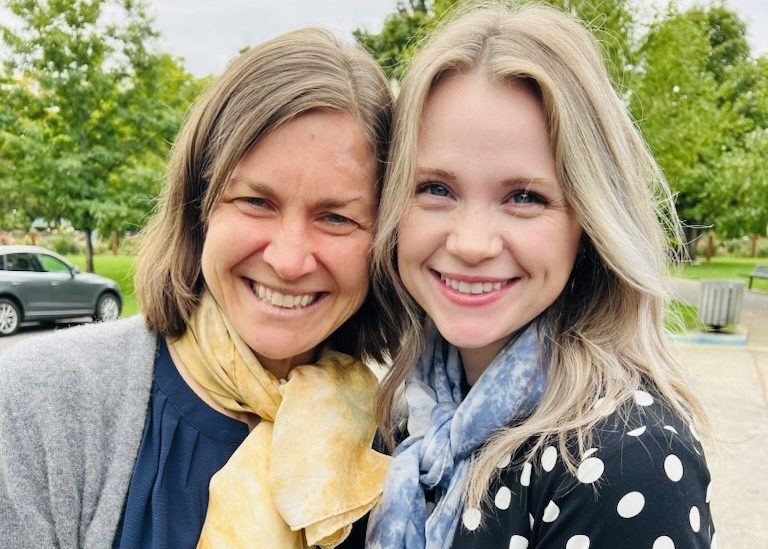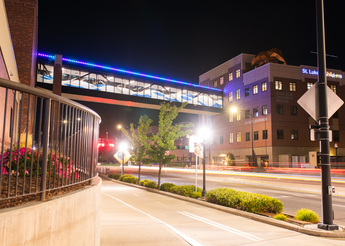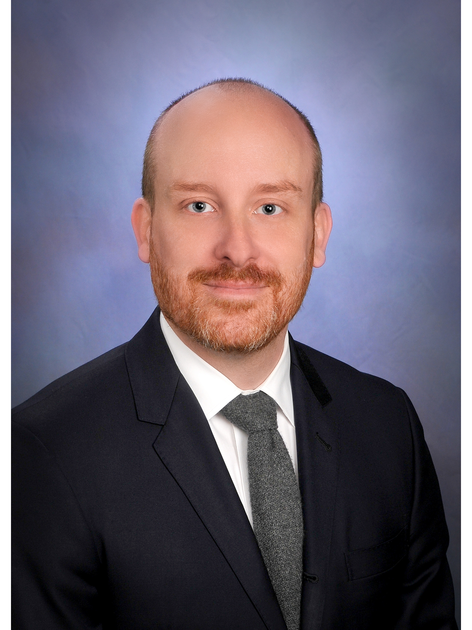
Dr. Gretchen Gudmundsen and Suicide Prevention Program Manager Fallon Baraga, co-chairs of the Suicide Prevention Collaborative

Dr. Gretchen Gudmundsen and Suicide Prevention Program Manager Fallon Baraga, co-chairs of the Suicide Prevention Collaborative
Help & Support

In honor of National Physician Suicide Awareness Day, the skybridge at the St. Luke’s Boise Medical Center was illuminated in purple and teal on Wednesday, Sept. 17. These colors represent hope, remembrance and advocacy for physician and provider mental health.
By Dave SouthornLast Updated September 25, 2025
September is National Suicide Prevention Month, during which Sept. 10 is World Suicide Prevention Day and Sept. 17 National Physician Suicide Awareness Day. But efforts to reduce suicide in our communities and increase awareness of resources are every day.
St. Luke’s not only has a team dedicated to suicide prevention but has initiatives that include diverse groups from physicians to behavioral health experts to licensed social workers and many in between.
Idaho currently has one of the nation’s highest suicide rates. From 2022 to 2023, the rate rose by 4.7%, and suicide remains the second leading cause of death among teens and young adults ages 15 to 23.
These numbers also illuminate opportunities for prevention. National research shows that health care utilization is common among individuals who die by suicide. Nearly 30% had a health care visit in the seven days prior to death. More than half had a visit within 30 days, and more than 90% within the year.
On average, individuals who died by suicide had 16.7 health care encounters in the 12 months leading up to their death. The relative risk of suicide was highest among those seen in inpatient care, with emergency department visits also showing both high risk and high utilization.
This data underscores a critical point: Health care settings are not just places of treatment — they are often points of intervention. Equipping care teams with training and tools to recognize risk can transform everyday health care encounters into opportunities for connection, support and prevention
St. Luke’s Suicide Prevention Collaborative was established in 2022, bringing together a diverse group of experts to champion suicide prevention initiatives. Some of the collaborative’s highlights are included below.
Earlier this year, St. Luke’s released updated Help is Here! guides, community resources for suicide prevention, emotional and mental health support, for all of St. Luke’s operating regions. The updated guides are available in both English and Spanish and share important information about mental health risk factors, urgent warning signs and resources that community members can access, ranging from counseling and prevention to crisis intervention. The guides can be accessed online and have also been shared with community partners and locally in highly visible areas.
St. Luke’s is also a principal funder and is actively involved in the Communities for Youth, or C4Y, initiatives to address youth mental health through an evidence-based, upstream prevention approach. In one participating school district, middle and high school students’ self-reported depression rates decreased by more than 52% in a two-year period.
Earlier this year, the St. Luke’s Wood River Foundation invested $4.43 million in the Blaine County Mental Well-Being Initiative, a community-wide, collaborative effort that the St. Luke’s Community Health & Engagement team and Behavioral Health teams are heavily involved in, addressing mental well-being in the community.
St. Luke’s celebrated the grand opening of its new Twin Falls Behavioral Health Clinic in 2024 and a newly expanded Boise Behavioral Health clinic in August, both increasing space for clinicians and patients.
In 2023, St. Luke’s launched a Zero Suicide pilot project. At its core, Zero Suicide, a national movement and framework, challenges the notion that suicide is often viewed as inevitable. The effort calls on health care organizations to lead with intention, train staff in compassionate and effective responses, improve screening and follow-up, and build safety into every step of care.
The framework is built on seven key elements:

Dr. Mike Walton
Dr. Mike Walton, medical director of St. Luke’s Behavioral Health, has seen examples of teamwork leading to success in the march toward zero suicides.
Earlier this year, a patient called a St. Luke’s Behavioral Health clinic to schedule a first appointment. The patient expressed suicidal distress, and because of this, the call was quickly routed to St. Luke’s Social Work Crisis and Consultation Team.
“The CCT social worker stayed on the line, offering steady, compassionate support,” Dr. Walton said. “While maintaining calm, the social worker signaled to two nearby colleagues, who quickly coordinated with emergency responders. They relayed updates in real time, helping prepare first responders for what to expect.
“Because the patient was at home, the team couldn’t control the environment, but they had each other. Their coordinated response helped the patient stay calm and connected until help arrived.”
Dr. Walton noted his appreciation for “every team member who shows up with presence, urgency and care.”
He added: “This is suicide prevention in action.”
-St. Luke’s suicide prevention program manager Fallon Baraga contributed to this story